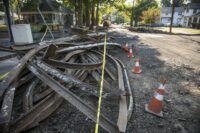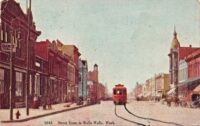 About 450 feet of 114-year-old trolley tracks were removed last week from downtown Walla Walla, Washington. They were pulled to make way for new utility work.
About 450 feet of 114-year-old trolley tracks were removed last week from downtown Walla Walla, Washington. They were pulled to make way for new utility work.
Significant stretches of the tracks remained embedded in the city’s roads. They were left undisturbed until 2011 when city water main improvement projects that would necessitate the removal of sections of track spurred an archaeological survey of the site. Using metal detectors, magnetometers and good old-fashioned shoe leather, archaeologists traced the trolley rails and recorded where they were visible and where they might be present under smooth asphalt.
Walla Walla’s first street car system began in 1889 and was horse-drawn. The cars ran on a standard gauge track with most of the rails installed in a cement base eight inches thick. It lasted a decade before plans to upgrade to an electrified system fell through and the horse-drawn street cars ceased operations in 1899.
 Come the opening of the Walla Walla River hydroelectric plant in 1905, electrical power became more easily available in the city, in 1906, the Walla Walla Valley Traction Company built the first electric trolley system. At first it was just one line between the railway depot to the city park. By 1918, there were an estimated 14 miles of trolley tracks in the city, plus dozens more in extensions to the suburbs, neighboring cities ( Milton and Freewater, 14 miles away across the state line into Oregon) and spur lines to national train lines and shipping on the Columbia River.
Come the opening of the Walla Walla River hydroelectric plant in 1905, electrical power became more easily available in the city, in 1906, the Walla Walla Valley Traction Company built the first electric trolley system. At first it was just one line between the railway depot to the city park. By 1918, there were an estimated 14 miles of trolley tracks in the city, plus dozens more in extensions to the suburbs, neighboring cities ( Milton and Freewater, 14 miles away across the state line into Oregon) and spur lines to national train lines and shipping on the Columbia River.
The urban trolley system was a major economic boon to workers and to businesses, providing inexpensive, quick and reliable transportation to people and freight. It was a short-lived boon. The advent of the car killed the trolleys but good and Walla Walla’s city trolley system was shut down for good on December 31st, 1926. The service to Oregon, ceased in 1931.
In 1926, the city determined that only the tracks on brick or unpaved areas needed to be removed. The ones on paved streets would simply be abandoned. As roads were asphalted, the rails would be covered up with nobody the wiser. The sections of track visible today were exposed by erosion of the asphalt layer which, as it happens, does not bond well to iron rails.
The 2011 survey concluded that much of the Walla Walla Valley Railway Company’s rails were still in place under the surface and exposed in discreet areas. Intersections and areas with recent infrastructure work did have the old tracks removed. The section beneath Whitman Street had 4000 feet of railway. Archaeologists determined that this section was not contiguous and having been buried for decades, they were unlikely to shed new light on the history of public transportation in Walla Walla. They recommended the utility work continue and that the rails be fully documented upon removal. Archaeologists kept only one section of the rail which was stamped with a date and manufacturer name. It is now at the Fort Walla Walla Museum.
The same principal was applied a week ago, when workers pulled 450 feet of the rails under Whitman to proceed with plans to repair and replace water, sewer and road infrastructure.
This is fairly common in cities which had street railways. It was easier and cheaper to pave over the old tracks after abandonment than it was to remove them. If they haven’t been documented the old rails can come as a nasty surprise to subsequent street and utility work. Some years ago the City of Denver, Colorado was upgrading certain downtown streets for grand prix racing and found forgotten trolley tracks which complicated the work and caused more expense for their removal.
Would this metal be untainted by the Atomic bomb radiation? If so, it will be valuable.
Susi,
Since no atomic bomb has ever been dropped on Walla Walla, Washington, or exploded nearby, there is be no radiation to worry about. You possibly are thinking of ground contamination at Hanford?
The steel was of good quality, and does have some scrap value, though perhaps not enough to cover the cost of its removal.
Here in Charlottesville, Virginia, we have the same problem with old tracks below the current pavement that were paved over nearly 90 years ago. Every time they are a nuisance for some construction project, the rails become a brief news item in the local paper or 6 o’clock TV news. Then they are forgotten until next time. Given that the city is talking about a major street upgrade between the downtown and the University of Virginia campus, the former route for our streetcars, there will probably be another round of news stories soon.
Yours Aye,
Garth Groff
No Garth, Susi is quite rightly pointing out that all steel manufactured after the first nuclear bomb in 1945 is contaminated with radiation making the manufacturing of such things as Geiger counters more difficult. The scuttled battleships from Scapa Flow (1919) have been utilized as a source of uncontaminated steel. It is a reasonable question to ask if the track steel would also be a good source.
https://en.wikipedia.org/wiki/Low-background_steel